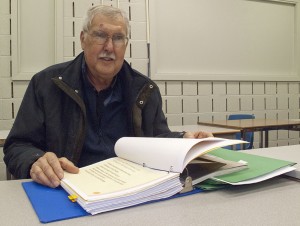
(Belleville, 01/17/2012) John Sager flips through his research and the beginnings of his manuscript for his first book which will document every rural schoolhouse in Hastings County. Photo by Jennifer Bowman
By Jennifer Bowman
Courtsey of Rural Hastings Advocate [1]
An understaffed event at the Heritage Museum in Stirling had an unexpected outcome. A book.
John Sager, a retired certified management accountant, was filling in at the schoolhouse exhibit at the Agribition Tour in October.
The tour at the museum is offered to Grade Four students at local schools so they can learn about agriculture and where their food comes from.
“Originally all I was supposed to have done was ring the bell to change the stations as they moved along,” said Sager.
He volunteered to fill in at the schoolhouse until more volunteers came. No one showed up, so three days and 23 presentations later, he was a semi-expert on what life was like in the schoolhouse in the 1920s.
The script for tour visitors kept changing as he went through.
“When I was finished, I said, ‘Well, we really do need to have a script so that next year someone can do this’,” he said.
While writing the script, he talked to retired teachers so he could find out what their salary was and what the programs were like.
Those phone calls led him to a 95-year-old woman in Madoc who used to teach at one of the schools in Madoc Township. She showed him a book she had written using desktop publishing with the help of her grandson and granddaughter.
“I said, well, if she can do that, why can’t we do something? There’s no book to my knowledge that has all of the history of Hastings County schools recorded in one book,” he said.
His plans to document stories from every rural schoolhouse in Hastings County, about 200 of them. He’s doing a lot of research, but he said he’s not writing much for it. Instead, he’s asking permission from authors who have published historical works of the area to use segments or their work.
“I’m stealing information wherever I can,” he said.
He’s also collecting anecdotes from people who attended or taught at the schools.
One woman he talked to went to one of the rural schools in the 1915, then taught from the late 1920s till the 1960s. She is now 103. Another anecdote told of a woman who took her teacher’s exam with the superintendent while he was plowing his field.
“The purpose is to document for my grandkids what school was like. And hopefully the people that buy the book will want to pass this on to their grandchildren as well,” Sager said.
It’s been an educational journey, even for Sager, who went to a rural school.
He said he found there were several schools with windows only on the left side of the school. He deducts the reason was to encourage students to write with their right hand. Many of the schoolhouses had only natural light, and light coming in from the left wouldn’t cast a shadow if a student wrote with their right hand.
He’s hoping to have the book finished so that it can be launched on Grandparent’s Day in September at the Hastings County Museum of Agricultural Heritage.